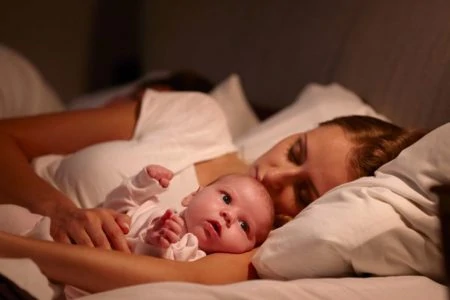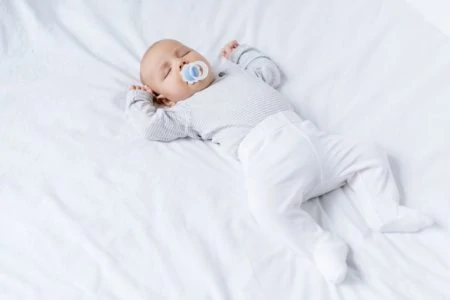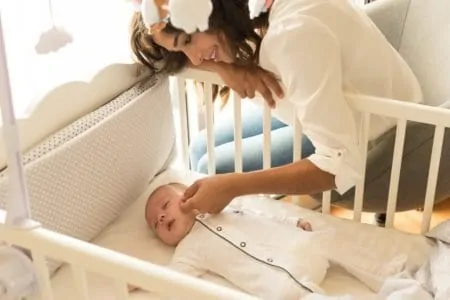New parent panic is real. You spent nine months with your baby safely tucked inside you, so the thought of putting them in another room can feel unnatural or even scary.
It is normal to feel unsettled when you are separated from your newborn. However, sleep safety is the most critical factor to consider when deciding where everyone catches their Zs.
Before you pull the baby into your bed or set up a nursery down the hall, you need to understand the terminology. Let’s break down the differences between co-sleeping, bed-sharing, and room-sharing to help you make the safest choice for your family.
Key Takeaways
- Room-sharing is the gold standard: The AAP recommends keeping your baby in your room (but on their own surface) for at least the first six months.
- Know the definitions: Bed-sharing means sleeping in the same bed; co-sleeping usually refers to a separate surface attached to or near the parent’s bed.
- Bed-sharing carries risks: While cultural practices vary, bed-sharing increases the risk of SIDS and accidental suffocation.
- Intentionality matters: Unplanned bed-sharing (falling asleep by accident) is more dangerous than setting up a specifically prepared safe sleep space.
What Are My Options for Sleeping?
Sleep deprivation is torture, and finding a way for everyone to rest is a top priority. Generally, there are three ways to keep your baby close while you sleep:
- Bed-sharing.
- Co-sleeping.
- Room-sharing.
People often use these terms interchangeably, but they are technically different arrangements with different safety profiles.
The American Academy of Pediatrics (AAP) recommends room-sharing for at least the first six months of your baby’s life, though ideally for the first year (1). However, they advise against bed-sharing due to safety concerns.
Let’s look at the nuances of these methods to see which fits your parenting style.
1. Bed-sharing
Bed-sharing is exactly what it sounds like; your baby sleeps directly on your mattress with you. This is often appealing to breastfeeding mothers or parents practicing attachment parenting who want maximum closeness.
You have likely heard warnings against this. Campaigns in the U.S. and the U.K. advise against sharing a bed to minimize the risk of Sudden Infant Death Syndrome (SIDS) or accidental suffocation.
However, research suggests bed-sharing can be done with reduced risk when practiced intentionally, particularly by breastfeeding mothers who do not smoke or use substances (2).
Parents usually choose to bed-share for these reasons:
- Separation anxiety: They do not want to leave the baby alone.
- Convenience: Breastfeeding is much easier when you do not have to get up.
- Sleep quality: Some babies simply refuse to sleep unless they are touching a parent.
- Space or budget: Financial considerations might prevent parents from buying a separate crib or bassinet immediately.
I have been there. When I was pregnant with my second, my toddler was going through a regression. Some nights, the only way she slept was next to me. It was a survival tactic for my exhausted, pregnant self.
Bed-Sharing Know-How
If you are considering this route, you must understand why it is risky. Adult beds are not designed for infants.
- Fall risks: Adult beds are high, and the lack of bed railings makes falling a serious danger.
- Soft surfaces: Adults like soft, pillow-top mattresses. Baby cribs are firm for a reason; soft surfaces can cause a baby to sink and suffocate.
- Loose bedding: Pillows, duvets, and sheets can easily cover a baby’s face, leading to suffocation or overheating.
The risk of SIDS is greatest in your baby’s first four months of life. If you are worried about SIDS, you may want to wait until the peak risk has passed before bed-sharing. You can room-share or co-sleep until then (3).
Editor's Note:
Michelle Roth, BA, IBCLCIf you plan to bed-share, or think you might fall asleep while feeding, strict safety measures are non-negotiable (4):
- Consider feeding method: Breastfeeding mothers instinctively curl around the baby (the “cuddle curl”), creating a protected space. Bottle-fed babies should ideally co-sleep or room-share instead (5).
- Get partner agreement: Everyone in the bed must know the baby is there. If your partner is not on board, it is not safe.
- Stay sober: Never bed-share if you have consumed alcohol, drugs, or medications that make you drowsy. This includes heavy sleep aids.
- Know your sleep depth: If you or your partner are extremely heavy sleepers who do not wake easily, bed-sharing is too risky.
- Consider body weight: Obesity can sometimes affect how much space you take up on the bed or your ability to feel exactly where the baby is. A separate co-sleeper attachment may be safer (6).
- No smoking: Do not bed-share if you or your partner smoke. Smoking during pregnancy or exposure to second-hand smoke increases SIDS risks significantly.
- Dress appropriately: Keep blankets away from the baby. Wear warm pajamas so you do not need heavy duvets, and dress the baby warmly so they do not need loose covers.
- Prep the environment: Move the bed away from walls to prevent entrapment. Strip the bed of pillows and heavy quilts. Ensure the mattress is firm and never use a waterbed or sofa.
- No siblings or pets: The family bed sounds cute, but toddlers and pets are unpredictable. Keep them out of the bed while the infant is there.
Need to know more about safe bed-sharing? Researcher Helen Ball and her team in the U.K. have a comprehensive website. James McKenna, an anthropologist and researcher at the University of Notre Dame, and his team are the leading experts in the U.S. on infant sleep.
Editor's Note:
Michelle Roth, BA, IBCLC2. Co-sleeping
Co-sleeping is the middle ground. In this setup, you sleep in your bed, and your baby sleeps in a bassinet or crib that physically attaches to the side of your bed. Think of it as a “sidecar” for your infant.
This gives you a separate, safe sleep surface for the baby while keeping them within arm’s reach. Most co-sleepers have a drop-down side, allowing you to touch, soothe, or pull the baby over for a feed without standing up.
Here is why many parents prefer co-sleeping:
- Best of both worlds: You get the closeness of bed-sharing with the safety of a separate surface.
- Easier nursing: You can breastfeed at night with minimal disruption.
- Soothes fussy babies: Being able to smell you and hear your breathing often helps babies sleep longer.
- Reduces anxiety: You can see your baby just by opening your eyes.
- Safety: It aligns with AAP recommendations for room-sharing while offering more proximity than a crib across the room.
You might worry about the cost of buying a specialized co-sleeper. However, many models convert into standalone bassinets or playards, giving you more bang for your buck.
Safety Check
3. Room-sharing
Room-sharing is the most widely recommended method by pediatricians. This simply means the baby sleeps in your bedroom but on a completely separate surface, like a standard crib or portable playard.
This setup offers distinct advantages:
- Reduces SIDS risk: Studies show room-sharing decreases the risk of SIDS by as much as 50 percent.
- Easy monitoring: You do not need a fancy baby monitor to hear if they are fussy.
- Convenience: Night feeds are still easier than walking down the hall.
- Better sleep for some: If you are a light sleeper, having the baby a few feet away (rather than right next to your ear) might help you ignore the minor grunts and squeaks babies make.
Room-sharing creates a safe, independent sleep environment while keeping you close enough to respond quickly to your baby’s needs.
FAQs
The Bottom Line
Your instinct is to protect your baby, and keeping them close at night feels like the best way to do that. Whether you choose the “sidecar” style of co-sleeping or a crib in the corner for room-sharing, the goal is the same: safety and rest.
Weigh your options honestly. If you know you will be too exhausted to put the baby back in the crib, preparing your bed for safe sleep is better than accidentally falling asleep on a sofa. Make an informed decision that works for your family, follow the safety guidelines strictly, and try to get some sleep yourself!









